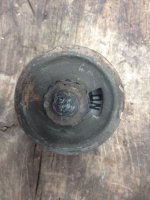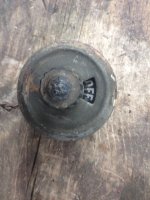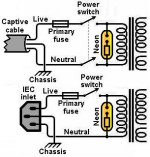The usual practice in Europe is for mains switches to be double-pole.
Note that the second wire is not "ground" but neutral.
I would avoid using a really old switch unless you are absolutely sure that the insulation is up to modern standards. This is especially true if other people might use the item.
Note that the second wire is not "ground" but neutral.
I would avoid using a really old switch unless you are absolutely sure that the insulation is up to modern standards. This is especially true if other people might use the item.
You could of course use a low voltage relay and switch it with your old switch. Check the working voltage of the switch before even thinking about using it to switch raw live mains voltage!
The usual practice in Europe is for mains switches to be double-pole.
Note that the second wire is not "ground" but neutral.
If your tube amp is Class I protected (i.e. three pole mains power connectors with chassis connected to neutral/"ground", the "gold standard" for diy tube gear), a single pole mains switch is safer and more reliable.
The predominant use of dual pole switches is due to the prevalence of today's class II gear, which requires dual pole switching to be safe.
Last edited:
No. This is because you can never be certain that 'neutral' really is neutral; electricians have been known to get this wrong, and people wiring plugs get it wrong too.If your tube amp is Class I protected (i.e. three pole mains power connectors with chassis connected to neutral/"ground", the "gold standard" for diy tube gear), a single pole mains switch is safer and more reliable.
Double pole switches are best for both Class I and Class II equipment. Single pole switches belong back in the era when electrical safety was not taken as seriously as it is today.
@goldenbeer: IMHO a single-pole mains switch is safer and more reliable only in situations where the physical design of the connector ensures that live and neutral connections can not be reversed. It does not depend on the ground connection. Even a class II device with a polarized connector would be safer with a single pole mains switch.
But: At least the german three pole mains connectors can be connected in two different orientations, reversing live and neutral. In this case, a two pole power switch is required to ensure that the live gets disconnected when the device is switched off.
Polarized connectors would solve the problem, but are rarely used.
Regards,
Rundmaus
But: At least the german three pole mains connectors can be connected in two different orientations, reversing live and neutral. In this case, a two pole power switch is required to ensure that the live gets disconnected when the device is switched off.
Polarized connectors would solve the problem, but are rarely used.
Regards,
Rundmaus
First, I mixed up english terms between neutral, ground & earth. Sorry for that, too much for my little german brain. I will now refer to the terms below (UK plug btw)

What I meant to say:
For class I equipment ( - and using isolation power transformers, the typical diy stuff - ) where the yellow-green earth is connected to the conductive housing, it is typically safest and most reliable to simply switch/break the mains loop on the primary side of the power transformer using a simple single pole switch.

What I meant to say:
For class I equipment ( - and using isolation power transformers, the typical diy stuff - ) where the yellow-green earth is connected to the conductive housing, it is typically safest and most reliable to simply switch/break the mains loop on the primary side of the power transformer using a simple single pole switch.
We may disagree on "overall safety", but certainly there's no doubt that the double pole switch has more potential failure modes, incl. the possibility of hidden or dormant failures. Single pole switch is the most reliable and the most obvious in (normal and abnormal) operation.
IN the first instance to the OP don't even think of using old switches for mains control.
In reference to the single pole switching scenario.
Its shown in several places like this:
The Valve Wizard
I cannot find any reference which supports this.
The only argument would seem to be that the IEC connector is a means of isolation, however this is not sufficient because its not an on load isolator so you are reliant on the mains plug and switch.
(ie dis-connecting all live connections) In the UK neutral is classed as a live connection.
However even in an IEC connected situation there is no mention of someone connecting the mains plug incorrectly.
Which negates the single pole switch idea with IEC polarity protection!
Then again its interesting to note that in double pole switching all precautions must be taken to ensure that the live is always disconnected for obvious reasons that should the neutral go open for any reason with the live still connected you have an appliance which appears to be dead but is electrically live. This is also the case where the neutral should not be fused. Ie the neutral fuse could go open and the appliance would appear to be off but is electrically live ie the live is still connected.
The problem still exists with standby which is not OFF.
There is a problem with convenience switching and isolation this is the problem with both offload isolation which is not relevant or on load isolation.
The term OFF and ISOLATED are not the same thing off is disconnected from supply and isolated is disconnected from all forms of energy (including stored charge)
The only option would appear to be double pole switching. However how to make sure that both poles disconnect every time.
Any switch used as double pole for switching must be fail safe! Every time.
The use of Double pole switching in the domestic environment helps with testing the installation by enabling disconnection of both the live and neutral before megger voltages are applied giving false readings also in earth Leakage tripping where an appliance may be at fault with a neutral to earth fault preventing RCD reset.
NB I would add I have seen and actually experienced an IEC plug weld in place with mains feeding large toroid loads!
Regards
M. Gregg
In reference to the single pole switching scenario.
Its shown in several places like this:
The Valve Wizard
I cannot find any reference which supports this.
The only argument would seem to be that the IEC connector is a means of isolation, however this is not sufficient because its not an on load isolator so you are reliant on the mains plug and switch.
(ie dis-connecting all live connections) In the UK neutral is classed as a live connection.
However even in an IEC connected situation there is no mention of someone connecting the mains plug incorrectly.
Which negates the single pole switch idea with IEC polarity protection!
Then again its interesting to note that in double pole switching all precautions must be taken to ensure that the live is always disconnected for obvious reasons that should the neutral go open for any reason with the live still connected you have an appliance which appears to be dead but is electrically live. This is also the case where the neutral should not be fused. Ie the neutral fuse could go open and the appliance would appear to be off but is electrically live ie the live is still connected.
The problem still exists with standby which is not OFF.
There is a problem with convenience switching and isolation this is the problem with both offload isolation which is not relevant or on load isolation.
The term OFF and ISOLATED are not the same thing off is disconnected from supply and isolated is disconnected from all forms of energy (including stored charge)
The only option would appear to be double pole switching. However how to make sure that both poles disconnect every time.
Any switch used as double pole for switching must be fail safe! Every time.
The use of Double pole switching in the domestic environment helps with testing the installation by enabling disconnection of both the live and neutral before megger voltages are applied giving false readings also in earth Leakage tripping where an appliance may be at fault with a neutral to earth fault preventing RCD reset.
NB I would add I have seen and actually experienced an IEC plug weld in place with mains feeding large toroid loads!
Regards
M. Gregg
Last edited:
We may disagree on "overall safety", but certainly there's no doubt that the double pole switch has more potential failure modes, incl. the possibility of hidden or dormant failures. Single pole switch is the most reliable and the most obvious in (normal and abnormal) operation.
I agree with what you say its a strange situation.
Switching a neutral and live (DP) is strange and is understandable with the reversible plugs and sockets and the class of appliance (ie not a portable appliance or tool)
However..
I know you already know this..😀
Its just for peace of mind.
Obviously the Earth protective cable must never be switched or fused in any way.
So much for the OP's simple question..😀
And we haven't touched on current inrush and welding.
Regards
M. Gregg
Last edited:
Well this turned into in interesting conversation. I am already using old knife switches to activate relays for my inputs so I might as well do the same for the power too....using the proper relay of course.
Well this turned into in interesting conversation. I am already using old knife switches to activate relays
for my inputs so I might as well do the same for the power too....using the proper relay of course.
Just never assume that the house wiring is right. I've seen entire houses here in the US wired backwards.
For my own info, European residential 220 vac is single phase, not 2 phase like here in North America correct?
It may not seem kosher in this day and age, but if you look at the schematic for any old fener amp, you will see a signle pole mains switch and associated wiring.
In the USA, where the OP resides, the neutral is bonded to the earth in the electrical service panel. That doesn't mean outlets cannot be miswired of course.
relays are fine, but for a mains relay circuit, the system has to be powered at all times to the extent a relay supply is present.
Your simple switch can also control a triac to switch mains power off and on.
In the USA, where the OP resides, the neutral is bonded to the earth in the electrical service panel. That doesn't mean outlets cannot be miswired of course.
relays are fine, but for a mains relay circuit, the system has to be powered at all times to the extent a relay supply is present.
Your simple switch can also control a triac to switch mains power off and on.
European domestic supplies are officially 230V single phase. In the UK they are mainly 240V or sometimes higher.
There is a very simple rule for this:
For class-I apparatus, BS/EN/UL60065 states that if you use a captive mains cable, you must use an all-pole mains switch, i.e. both live and neutral (but not earth); the power switch is for safety.
If you use a detachable IEC lead then you can use whatever power switch you like (or none at all); the power switch is for user convenience, not safety.
For class-I apparatus, BS/EN/UL60065 states that if you use a captive mains cable, you must use an all-pole mains switch, i.e. both live and neutral (but not earth); the power switch is for safety.
If you use a detachable IEC lead then you can use whatever power switch you like (or none at all); the power switch is for user convenience, not safety.
Last edited:
i think that the local electrical code is the determinant to what switching arrangement to use...
so depending on where you are, you can follow the local codes...
so depending on where you are, you can follow the local codes...
- Status
- Not open for further replies.
- Home
- Amplifiers
- Tubes / Valves
- simple question about on off switch


